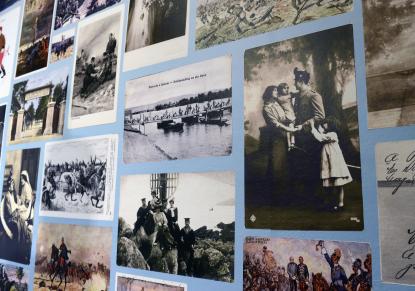2024. May 2. Thursday
- Budapest
|
|
Address: 1014, Budapest Ybl Miklós tér 2-6.
Phone number: (1) 225-0554 /292
E-mail: info@varkertbazar.hu
Opening hours: Tue-Sun 10-18
Neoreneszánsz Garden: Mon-Sun 10-18 |
The exhibition has closed for visitors.
2015.07.08. - 2015.10.30.
The new generation was bored, and was thirsty for dashing and dangers adventures.

(Ferenc Herczeg)
Supported by The First World War Centenary Commemorative Committee and the professional arrangement of the 20th Century Institute a First World War exhibition opens in the Castle Garden Bazaar.
The material featuring items on the Great War world, which radically changed the previous world order: the empires previously thought to be stable, disintegrated culture and public opinion also changed dramatically is presented on nearly 600m2. World War buried the old world, its consequences was the world on fire, then the Cold War. Europe bled out in brothers at war only for the 20th century to be dominated by America and Russia.
The exhibition guides the visitors from the happy times of peace over war enthusiasm to a bitter disillusionment. We show how civil society was swept away by the industrialized war spreading worldwide, how faith in progress dominating the 19th century and how the hinterland turned into a battleground. The nature of war changed: now the victory is the result of the amount of war material.
The exhibition opens on July 8, it brings the visitors closer to the horrors of war by unique visual solutions : the all-consuming, total destruction is portrayed by way of a steaming black swamp , while brutal massacre is represented by a slaughterhouse. Visitors can explore a trench, and may face the propaganda effect of mobilizing the masses as well.
We deal with the effect of the war on the health system, and its development and the surfacing of new medical procedures. Emphasis is put on changes in the role of women and the family, in the "corridor of Heroes" the portrait of more than 300 soldiers killed in action is shown, who fought in the army for the Historic of Hungary.

(Ferenc Herczeg)
Supported by The First World War Centenary Commemorative Committee and the professional arrangement of the 20th Century Institute a First World War exhibition opens in the Castle Garden Bazaar.
The material featuring items on the Great War world, which radically changed the previous world order: the empires previously thought to be stable, disintegrated culture and public opinion also changed dramatically is presented on nearly 600m2. World War buried the old world, its consequences was the world on fire, then the Cold War. Europe bled out in brothers at war only for the 20th century to be dominated by America and Russia.
The exhibition guides the visitors from the happy times of peace over war enthusiasm to a bitter disillusionment. We show how civil society was swept away by the industrialized war spreading worldwide, how faith in progress dominating the 19th century and how the hinterland turned into a battleground. The nature of war changed: now the victory is the result of the amount of war material.
The exhibition opens on July 8, it brings the visitors closer to the horrors of war by unique visual solutions : the all-consuming, total destruction is portrayed by way of a steaming black swamp , while brutal massacre is represented by a slaughterhouse. Visitors can explore a trench, and may face the propaganda effect of mobilizing the masses as well.
We deal with the effect of the war on the health system, and its development and the surfacing of new medical procedures. Emphasis is put on changes in the role of women and the family, in the "corridor of Heroes" the portrait of more than 300 soldiers killed in action is shown, who fought in the army for the Historic of Hungary.

